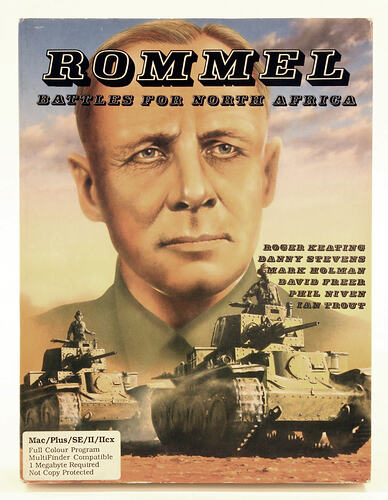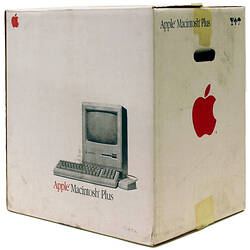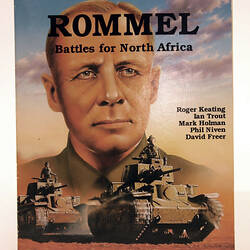Summary
'Rommel Battles For North Africa' is a game dealing with six battles for the North African Campaign during World War II, made in Australia in 1990 by the Strategic Studies Group. This game is an example of the early use of the mouse for navigation and input of data. The game could also be played on IBM or compatible machines but by only using the keyboard.
This is a Macintosh version using 3½ inch disks There is an Apple II version that uses 5¼ inch floppy disks.
This is one of the first series of games in which software micromanaged the actions of the individual units, for example, battalions or artillery assets.
The series used the same format but different battle scenarios in different theatres of war. In the Macintosh version, titles included Macarthur's War, Halls of Montezuma and Panzer Battles. The Macintosh allowed mouse control and had higher definition graphics. The Apple II version used keyboard control.
The setting is the North African campaign in World War II. There were eight scenarios. There was also a campaign editor that allowed users to create their own scenarios, as many as they liked. The one player was the divisional or corps commander and the player could play either side. The commander gave general orders to battalions and regiments. The software would then micromanage the orders.
The game had a sound capability that was determined by the limitations of the hardware.
This program was distinctive because it was developed for cross-platform use. Versions were available for the Apple II, Apple IIgs, the IBM PC and the Macintosh and the Amiga computer systems. The program adhered to the strict design requirements of the Apple usability guidelines giving consumers greater confidence in the correct operation of the product.
This object was collected because it was designed and produced by an Australian software development company, the Strategic Studies Group, commonly known as SSG, that makes strategy war games.
It was also collected because it is representative of the use of the graphic user interface (GUI) introduced in 1983, even though the game itself was released in 1990.
In 1983, the donor's parents gave him an Apple II Europlus. He used it for essays, medical school assignments and games. He became especially interested in war games and he stated that an Australian Sydney-based company Strategic Studies Group had the best war games at that time, which he began and continued to collect.
Part of a representative collection of hardware, software, trade literature and promotional material that documents the history of the Apple company, and its contribution to, and impact on the computer industry and society.
Physical Description
A white cardboard box in printed sleeve. The box contains two black floppy disks with labels, a scenario booklet of 40 pages, a Games Manual of 31 pages and a subscription order form.
More Information
-
Collection Names
The Apple Company Collection, Internet Macintosh User Group (iMug) Collection
-
Collecting Areas
-
Acquisition Information
Donation from Chee-Yan Hiew, 22 Nov 2006
-
Manufacturer
Strategic Studies Group, Sydney, Greater Sydney, New South Wales, Australia, 1990
-
Format
Magnetic carrier, Floppy disk, 3.5 inch
-
Inscriptions
On sleeve: " Rommel Battles for North Africa - Roger Keating, Danny Stevens, Ian Trout, Mak Holman, Phil Noven" with a sticker: " Mac/Plus SE/II IIcx Full colour Program; mulit finder compatible, 1 Megabyte Required not Copy protected" The rear has introduction and screen images and the following text: ©1990 Strategic Studies Group. Made in Australia 1: The booklet: "Battlefront Game System" 2: "Rommel - Scenario Booklet" Floppy Disk Labels: "Rommel Battles for North Africa - Disk One" MACINTOSH ©1990 SSG Version All Rights Reserved
-
Brand Names
-
Classification
-
Category
-
Discipline
-
Type of item
-
Overall Dimensions
245 mm (Length), 185 mm (Width), 30 mm (Height)
Approximate case dimensions.
-
Keywords
Computer Games, Computer Software, Computers, Computing, Education, Entertainment, World War II, 1939-1945, Innovation & Design




